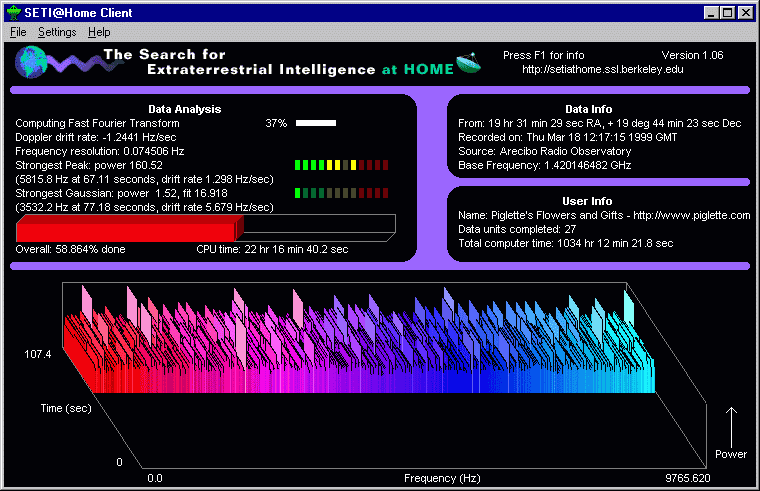The Earth travels around the Sun at around 66,700 miles (107,000 kilometers) an hour, or 18.5 miles (30 kilometers) a second. Also, the Earth itself is rotating on its axis at approximately 1,000 miles per hour (1,609km/hr). Not only that, but everything else is in motion too - the sun is travelling through the galaxy and the Milky Way itself is in motion compared to other galaxies too. All of this means that signals from a remote civilizaton will be distorted by the doppler effect - an effect similar to the way that the apparent frequency of a honking car passing you causes the pitch of the sound to be different compared as it approaches you to after it has passed you. Because of this, the SETI@home screensaver needs to compensate for the doppler effect by de-chirping the signals. The program analyzes the data many times over trying a a large variety of different possible Doppler accelerations before feeding the resulting "de-chirped" data to the FFT (Fast Fourier Transform) routines. The fast fourier transform routines heat SETI carries out are complex mathematical operations which are used to transform a set of time-based data into a set of frequency-based data. Time-based data is basically a waveform of voltage against time, whereas the frequency based-data is a spectrum of power against frequency. One of the tests that the SETI screensaver carries out to determine if a radio wave was generated by a distant Extra Terrestrial intellincence rather than being from intereference from Earth is to test for gaussian patterns. A gaussian pattern is a bell-shaped curve. If it finds anything resembling a gaussian curve, SETI at home will display a "best gaussian" power and fit values. The lower the fit value the better, and the higher the power value. The SETI@home screensaver will return Gaussians with a power more than 3.2 times the average noise level, and a fit of below 10. The screensaver will also look for what are known as triplets. A triplet is a set of three spikes spaced equally over time. The "power" gives information of the strength of the triplet relative to noise. The "period" is the time in seconds separating the three spikes. Aliens may be using a series of spaced pulses (like our own morse code) rather than a continuous or regular tone. Therefore the program uses a test called a "fast folding algorithm" which looks for pulsed patterns. If a set of repeating pulses is found, statistics showing power, period and score will be shown. Higher values of power and score are generally better than lower values. SETI@home will also look for single spikes. These are radio waves occurring at single frequencies which are strong enough to be distinguished from general noise. The Data Info section The Data Info section at the top left of the screensaver provides details about the particular "data unit" which your computer is working on. It tells you from what part of the sky (divided into degrees, minutes and seconds) this particular data unit was recorded and when it was recorded. It also gives details of what source did the recording (which will normally be the Aricebo Radio Observatory in Puerto Rico unless disaster strikes Aricebo) and the "base frequency" which tells you what part of the frequency spectrum your 9765 Hz of data is analysing. The User Info sectionThe User Info section shows your name or company to confirm that you'll be credited for processing this data unit. It also shows how many data units you have completed in total, and how much time your computer has spent looking for aliens and ufos. The SETI@home Frequency - Time - Power graphFinally, the Frequency - Time - Power graph shows a graphical representation of the fast fourier transformation that the SETI@home program is calculating. Here you can notice the difference between the different frequency resolution fast fourier transformations. For a resolution of 0.075 Hz you only do 8 fast fourier transformations are done to cover the 107 seconds of data. This has a different appearance to the 0.14 Hz resolution where 16 fast fourier transformations are done. Each time the frequency resolution is reduced by 1/2 (doubling the bandwidth) there is twice the time resolution (twice the number of fast fourier transformatons are done).
© Piglette.com |


